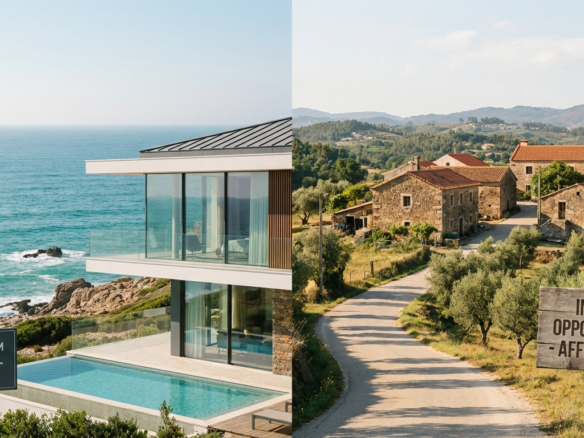In an era marked by dynamic migration patterns and shifting economic landscapes, Southeast Europe and Latin America are increasingly capturing the attention of savvy real estate investors across Europe. As traditional markets face saturation and regulatory complexities, these emerging regions present compelling opportunities driven by demographic shifts, infrastructural development, and evolving geopolitical factors. This article delves into the latest trends shaping these markets, offering a nuanced perspective tailored for European stakeholders seeking to diversify their portfolios and capitalize on new frontiers.
Get 50% OFF!
Subscribe to our newsletter and enjoy a 50% discount on all listing packages, no strings attached!

Understanding the Migration-Driven Real Estate Boom
Migration remains a pivotal catalyst influencing real estate markets worldwide. Southeast Europe, with its strategic location bridging Europe and Asia, is experiencing a notable influx of expatriates, expatriate workers, and international students. Countries such as Serbia, Croatia, and Bulgaria are witnessing increased demand for residential and commercial properties, fueled by both intra-European migration and foreign investment.
Similarly, Latin America is undergoing a demographic transformation characterized by urbanization and migration from rural areas to major cities like Mexico City, São Paulo, and Bogotá. These urban centers are experiencing heightened demand for housing, office spaces, and retail developments, driven by a burgeoning middle class and foreign investors seeking high-growth markets.
Key Trends in Southeast Europe
- Investment Flows and Market Growth: According to recent data, Southeast Europe’s real estate sector has attracted over €3 billion in foreign direct investment in 2023 alone, with a significant portion originating from European Union countries. The region’s relatively affordable property prices—averaging €1,200 per square meter in capital cities—combined with improving infrastructure, make it an attractive proposition for both residential and commercial investors.
- Residential Sector Dynamics: The rise in remote work and digital nomadism has spurred demand for high-quality, flexible living spaces. Cities like Zagreb and Belgrade are witnessing a surge in modern apartments targeting expatriates and young professionals, with rental yields reaching up to 7% in prime locations.
- Commercial and Industrial Opportunities: Logistics hubs and warehousing facilities are in high demand, especially as e-commerce continues to expand across the region. Countries such as Romania and North Macedonia are emerging as key players in this segment, supported by EU funding and infrastructural upgrades.
Latin America’s Market Dynamics
- Urbanization and Real Estate Development: Latin America’s urban centers are experiencing rapid growth, with the urban population expected to reach 85% by 2030. This demographic shift fuels demand for diverse property types, from affordable housing to luxury condominiums, often supported by government incentives and private sector investments.
- Foreign Investment and Market Resilience: Despite economic volatility, Latin America continues to attract European investors, particularly in Mexico and Chile, where political stability and economic reforms bolster confidence. The region’s real estate market saw an investment inflow of approximately €2.5 billion in 2023, emphasizing its resilience and growth potential.
- Emerging Sectors: Hospitality and tourism-related real estate are gaining prominence, especially in countries like Colombia and Costa Rica, which are capitalizing on eco-tourism and cultural tourism trends. Additionally, the rise of co-living and co-working spaces reflects changing lifestyle preferences among urban dwellers.
Strategic Considerations for European Investors
Investing in Southeast Europe and Latin America requires a nuanced understanding of local market conditions, legal frameworks, and socio-economic factors. European investors should consider the following strategic insights:
- Regulatory Environment: While some countries offer investor-friendly policies, others may pose bureaucratic challenges. Conduct thorough due diligence and partner with local experts to navigate legal procedures effectively.
- Currency Risks and Economic Stability: Fluctuations in local currencies can impact returns. Diversifying investments and employing hedging strategies can mitigate these risks.
- Infrastructure and Connectivity: Regions with ongoing infrastructural projects—such as new transportation links or energy developments—offer enhanced growth prospects and property appreciation potential.
- Sustainability and ESG Factors: Incorporating environmental, social, and governance considerations can enhance investment resilience and appeal to international tenants and buyers increasingly focused on sustainability.
Future Outlook and Opportunities
The convergence of migration trends, infrastructural investments, and economic reforms positions Southeast Europe and Latin America as compelling frontiers for European real estate investors. As these regions continue to evolve, opportunities abound in residential, commercial, industrial, and hospitality sectors. Notably, the integration of digital technologies and smart city initiatives will further enhance market attractiveness and operational efficiencies.
For instance, the European Commission’s recent emphasis on regional development and cross-border cooperation underscores the importance of strategic partnerships and sustainable growth models. Investors who proactively engage with these emerging markets, leveraging local expertise and innovative financing solutions, stand to benefit significantly in the coming decade.
Conclusion: Embrace the New Real Estate Frontiers
As the global landscape shifts, Southeast Europe and Latin America emerge as vibrant, high-potential markets driven by migration and demographic trends. European investors seeking diversification and long-term growth should consider these regions as part of their strategic portfolio. By understanding local dynamics, embracing innovation, and fostering sustainable practices, they can unlock substantial value in these promising frontiers.





Join The Discussion